October 18, 2013
Air Date: October 18, 2013
FULL SHOW
SEGMENTS

Overwhelming the Grid with Renewable Energy
View the page for this story
In Germany renewable energy is so popular that on a sunny day power generators produced more energy than the grid could handle. And instead of being paid for power, they had to pay to feed in their electricity. Harvard Professor Michael McElroy tells host Steve Curwood that similar problems are happening here in the US. (07:40)

Climate and the Health Risks of Urban Heat Islands
/ Cassandra ProfitaView the page for this story
Global warming is expected to increase summer temperatures and cities will be even hotter, as concrete and asphalt retain heat. The combination is expected to increase health risks. Cassandra Profita of EarthFix reports from Portland, Oregon. (06:50)
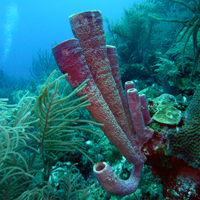
The Spongy Secret of Coral Reefs
View the page for this story
Since Darwin’s day, scientists have wondered how vibrant coral reefs thrive in the nutrient-poor waters of the tropics. Jasper de Goeij )of the University of Amsterdam in the Netherlands says that the humble sponge is the key. (06:37)
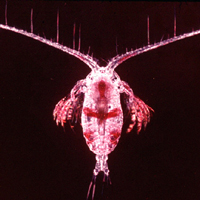
Copepod Love
/ Ari DanielView the page for this story
Tiny creatures at the bottom of the food chain have developed an ingenious way of finding mates, as Ari Daniel reports in this installment of Small Matters, the series that sweats the small stuff. (05:40)
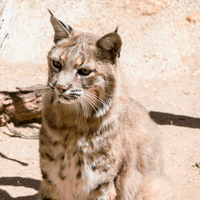
Bob the Cat
/ Mark Seth LenderView the page for this story
Bobcats are quite small and shy and hard to see - but as Mark Seth Lender observed, nobody should mistake them for a friendly tabby cat. (03:15)
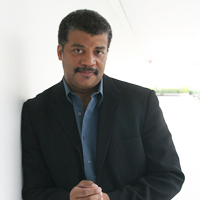
Gravity According to Tyson
View the page for this story
Astrophysicist Neil Degrasse Tyson joins host Steve Curwood to discuss the new movie, Gravity, and other news including Cassini's amazing discovery on Saturn's moon Titan. (17:00)
Show Credits and Funders
Show Transcript
Host: Steve Curwood
Guests: Michael McElroy, Jasper de Goeij, Neil de Grasse Tyson
Reporters: Cassandra Profita, Ari Daniel, Mark Seth Lender
[THEME]
CURWOOD: From Public Radio International, this is Living on Earth.
[THEME]
CURWOOD: I’m Steve Curwood. Deploying a lot of renewable power to displace polluting fossil fuels could take a huge investment in transmission lines and more political will.
MCELROY:Given the current political malaise if President Eisenhower had wanted today to build the interstate highway system, I don't think he would have a chance in hell of being able to do it. So I think we need to have a little bit more of a national sense of what our future is and what is the difference between consumption and investment.
CURWOOD: Also, scientists think they've solved a puzzle that intrigued Charles Darwin about coral reefs.
DE GOEJI: How can a coral reef which is very productive and colorful...how can it actually be such an ecosystem in those tropical seas that are such nutrient poor waters that the tropical seas are?
CURWOOD: The humble and surprising animal that's key to answering Darwin's question. We'll have those stories, and more this week on Living on Earth. Stick around.
[NEWSBREAK MUSIC: Boards Of Canada “Zoetrope” from “In A Beautiful Place Out In The Country” (Warp Records 2000)]
ANNOUNCER: Funding for Living on Earth comes from Stonyfield Farm. Makers of organic yogurt, smoothies and more.
Overwhelming the Grid with Renewable Energy

Solar energy is seeing a boon in Arizona (bigstockimages.com)
CURWOOD: From the Jennifer and Ted Stanley Studios in Boston this is Living on Earth. I’m Steve Curwood. One major key to cutting emissions of the global warming gas CO2 is the switch to renewable energy, and many nations offer huge incentives such as subsidies and production credits. But there are bumps on the road to cleaner energy, and in places, incentives have made for strange energy markets in the short term.
Consider; on June 15th this year - a long sunny day - there was so much wind and solar energy flowing in Germany that power generators actually had to pay to get the grid to accept their electricity. And it's not only in Europe; here in the US, a similar confusing pricing situation has been playing out in the Midwest and in sunny Arizona. Michael McElroy is a Professor of Environmental Studies at Harvard and says it's all a matter of mismatches in the energy markets.
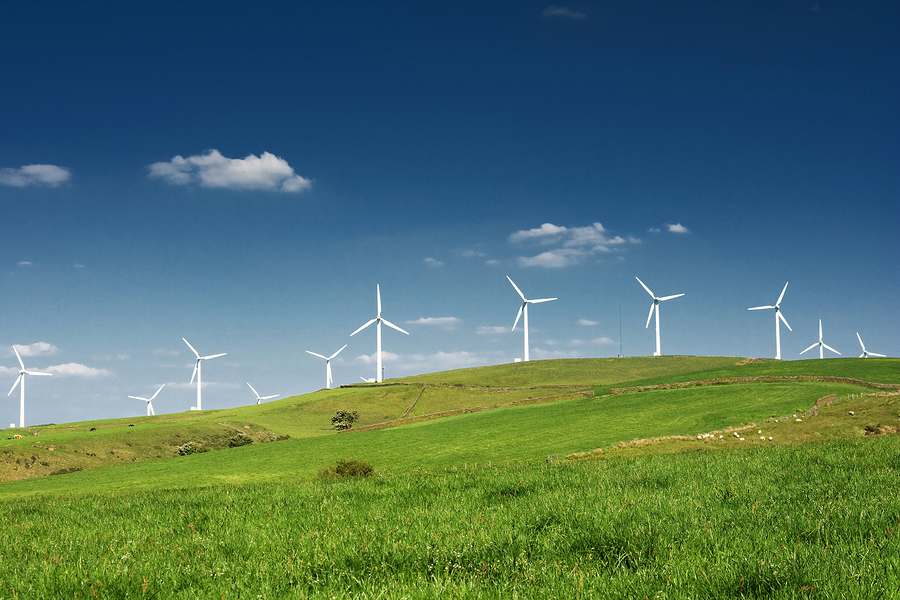
Wind farms and solar panels in Germany can potentially overwhelm the power grid. (bigstockimages.com)
MCELROY: There are two prices for electricity. There's the wholesale price - that’s the price at which the generators are delivering it to the grid. Then there’s the retail price - which is the price you have to pay to get it in your house. And there’s a significant different between the two. If I have a solar system on my roof of my house, the simplest way for me to see how to use that would be if I can run my electric meter forward and reverse. So if I’m simply running my meter in reverse, the utility view is, “OK. You’re now selling me the electricity at the retail price at a time when I’m having to buy it at the wholesale price. So effectively I’m subsidizing you under the circumstances.” And that’s the dilemma.
CURWOOD: Now I understand that the price of electricity also goes negative in the Midwest and the northern Midwest of the United States when there’s a lot of wind blowing.
MCELROY: So in large parts of the country, the wholesale price of electricity at night is very, very low, and during the day in summer it can be very, very high. It can actually go from slightly negative at night in some regions to over a dollar a kilowatt hour during the day when the demand is high.
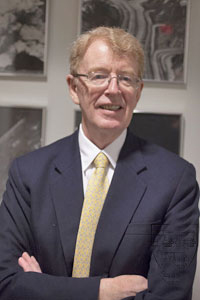
Michael B. McElroy is the Butler Professor of Environmental Studies at Harvard. (photo: Harvard University)
CURWOOD: But how do you get a negative price for electricity?
MCELROY: Well, you get a negative price for electricity in the United States because we have something called the production tax credit. So if I am generating electricity using wind or solar, I actually get a tax rebate at the moment of 2.3 cents a kilowatt hour for the electricity that I generate and deliver to the grid. So if I’m getting a rebate of 2.3 cents a kilowatt hour, I’m prepared to pay you 2.1 cents a kilowatt hour just to take my electricity because I’m still making a profit based on this production tax credit. Obviously the purpose of the production tax credit was to encourage the development of renewables.
CURWOOD: So break down Germany’s energy mix for me. How much do they produce through renewables versus coal and nuclear? And I gather there are different kinds of coal there?
MCELROY: Correct. The German system has moved pretty aggressively to address the climate problem. So they’ve done that with significant incentives for both solar and wind. And at the same time, the German reaction to the problem in Fukushima is effectively to get out of the nuclear business over some period of time. At the moment, the renewable energy mix is approaching 30 percent as I recall, with ambitions to go to 80 percent of the total demand by...I don’t quite know what the date is, maybe 2030, 2040? So in the meantime, they have significant solar, they have significant wind and they have some nuclear still operating, they have coal, and they have natural gas. With the coal and natural gas, there’s another problem, as it turns out, because natural gas prices in Europe and in Asia are relatively high, very high compared to the United States. So what’s happening in the U.S. is that our utilities are getting out of the coal business to some extent in favor of moving into natural gas. You can sort of see this directly in the recent trends in electricity generation, and so what’s happening to coal is that we’re exporting the coal to Germany effectively, so we’re actually supplying coal to Germany to produce electricity.
CURWOOD: As Germany phases out the nuclear power, reacting to the Fukushima disaster, why not just replace it with renewables?
MCELROY: The difficulty in relying solely on renewables is that the source is variable. So if the wind isn’t blowing, then the electricity generated by wind is reduced. If the wind is strong, then you’ve got an excess and so on. So the question, if you’ve got a very high fraction of your total generation coming from renewable variable sources, is how do you deal with that? The simple way to deal with it would be if you had the ability to store the excess electricity when you’re producing it. Batteries are not really an economically viable option at the moment, although they may be in the future.
CURWOOD: What is out there in terms of new battery storage technology that could potentially make the intermittent sources, make them more of a base load energy source?
MCELROY: In general the current state-of-the-art batteries is to store electricity with large batteries. It’s relatively expensive to do that, but a lot of good research is going on to try to change the economics of that, and I think there’s a real potential in the not-too-distant future - we’ll have cost competitive large scale battery storage. The cheapest way to store electricity is, if you have the option, you pump water up the hill when you have excess electricity, let the water run back down the hill and generate electricity when you need more. So that’s what’s called pump storage. And that’s actually happening in Europe, in particular between Denmark and Norway. So if you had a large interconnected grid, you have real advantages. If we had a really good grid that had coast-to-coast and border-to-border connection, then we can send the excess available in one region to some other place where it’s in short demand, and that’s a really good thing to do.
CURWOOD: At the end of the day, what do you think is the long-term capacity for renewable energy?
MCELROY: I think in the long term we should reasonably hope to move to a situation where we’re producing as much as maybe 80 percent or more of our electricity and other power demands with renewables. I think we have to do that in order to address the climate issue, but it’s a daunting challenge, and it’s not going to happen instantaneously. It’s going to have to be transitional time, and we have to address some of the issues of minimizing the variability of the power source from sources such as wind and solar. It requires smart grid connections, it requires smart ways to manage the system, but there are wonderful opportunities here to do a good job.
Now the cost of building a long distance transmission line - a rough number would be a million dollars a mile. So 3,000 miles...$1 million dollars...it looks like big money, but it’s really not big money when you consider the size of the economy, and also a significant part of doing that would be the labor cost of the construction. So it seems to me, if we’re thinking about jobs and economic advancement, those are issues that need to be dealt with now. Given the current political malaise, if President Eisenhower had wanted today to build the interstate highway system, I don't think he would have a chance in hell of being able to do it. So I think we need to have a little bit more of a national sense of what our future is and what is the difference between consumption and investment.
CURWOOD: Michael McElroy is Professor of Environmental Sciences at Harvard University. Thanks so much professor.
MCELROY: My pleasure.
Related link:
The Economist on Germany’s Renewable Energy Surplus
Climate and the Health Risks of Urban Heat Islands

An urban heat island is a part of the city where dark pavement and rooftops absorb sunlight and make the air around them hotter than the air surrounding areas. (image: the Heat Island Group)
CURWOOD: As global warming kicks in, scientists predict hotter summers, and the risks from increasing temperatures are higher in places known as urban heat islands. Pavement and buildings in cities hold the heat and can make hot spells more hazardous to human health. From Portland, Oregon and the public broadcasting collaborative EarthFix, Cassandra Profita reports for our series, “Symptoms of Climate Change”.
STEPHENS: Oh, kitty you’ll have to get down. Come on. Shoo.
PROFITA: 74-year old HelenRuth Stephens lives with her cat Chessie in a public housing complex near downtown Portland. Her building is surrounded by a black asphalt parking lot and a dense network of city streets lined with more apartments. Traffic whirs by on highway 405, three blocks away.
STEPHENS: I live in what scientists call an urban heat island. It's a part of the city that soaks up more of the sun's heat because it has a lot of buildings, pavement and vehicle traffic.
PROFITA: That means when it gets hot outside, it's even hotter in her neighborhood. And for Stephens, hot weather makes it hard to breathe.
STEPHENS: I find I'm totally de-energized. I can't move.
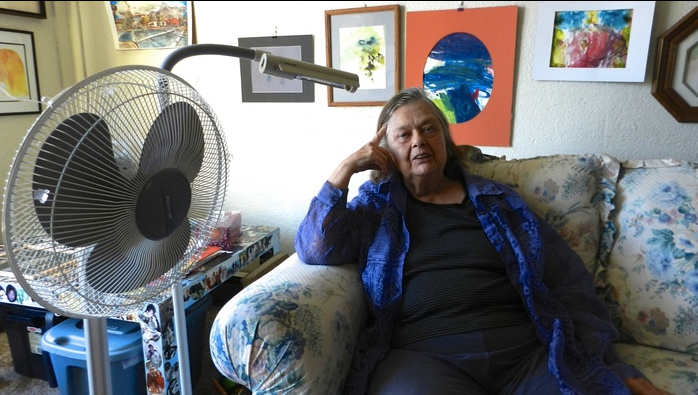
HelenRuth Stephens has asthma and chronic obstructive pulmonary disease. She says hot weather drains her energy and makes it hard to breathe. (photo: Cassandra Profita)
PROFITA: Stephens suffers from asthma and chronic obstructive pulmonary disease. Both affect her lungs. On hot days, she says, she doesn’t dare go outside. Not to get the mail or to take out the trash.
STEPHENS: You don't do it because you'll be breathless by the time you get back.
PROFITA: She’s the type of person public health officials worry about as they prepare for climate change. Climate models predict hotter summers and a higher likelihood of extreme heat events in the coming decades. And experts say that poses health risks – even in the milder climates of Oregon and Washington.
LUBER: Areas that don’t experience extreme heat are the ones that need to be thinking about it the most.
PROFITA: That’s George Luber, associate director of the climate change and health program at the Centers for Disease Control in Atlanta. Luber says climate models show cities like Portland and Seattle have every reason to prepare for hotter summers.
LUBER: While the Pacific Northwest doesn’t experience many extreme heat days, the potential of those are greatly increased – more so than other areas of the country.
PROFITA: The prospect of hotter summers has health officials taking a close look at urban heat islands. In Portland, studies show some parts of the city can get up to 9 degrees hotter than nearby rural areas. The heat alone poses health risks to the elderly, people with heart disease and diabetes. But it also creates another problem: It cooks air pollution into ground-level ozone, or smog.
DENNY: Ozone doesn’t do well with our lungs.
PROFITA: Justin Denny is the Multnomah County health officer in Portland.
DENNY: When that sun mixes with all the soup of pollution in the community from being in an urban environment, what happens is you create this ozone, which is a bi-product. If you have asthma or emphysema, you will find it more difficult to breathe.
PROFITA: The way Denny sees it, urban heat islands are a double-whammy for people’s health. The hottest places in the city are also more polluted. Add climate change to the mix, and the health risks of heart attacks, strokes and asthma attacks are even higher.
DENNY: You will take a person who’s not that healthy to begin with and push them to where they require medications and hospitalization and push people who are healthy into developing conditions like asthma.
PROFITA: Denny’s agency is developing a plan for responding to the health risks of climate change. The plan uses census data and maps of Portland’s urban heat islands. Its goal is to pinpoint the people whose health is most vulnerable in hot weather. The maps show a big blue cool zone in Forest Park – the city’s 5,000-acre urban forest. And there’s a big red hot zone all through downtown Portland.

A heat island map of the Portland, Oregon metropolitan area shows summer temperatures are higher downtown and along major roadways than in the shadier areas such as the 5,100-acre Forest Park. (image: Multnomah County Health Department)
SAILOR: There’s a fair amount of warming in these dense, concrete, asphalt jungles, freeway interchanges in downtown areas.
PROFITA: That’s Portland State University professor David Sailor. He developed those maps by taking detailed measurements of temperatures across the city during the summer months.
SAILOR: And then of course, one thing that’s impossible to miss in these figures is the fact that Forest Park stands out as what we call a cool island.
PROFITA: Cities across the country are looking for ways to cool down their urban heat islands. With climate change likely bringing warmer summers. They want to know how they can make downtown more like an urban forest. Can they reduce health risks simply by planting more trees? Portland State University researcher Vivek Shandas is working on an answer to that question.
[CAR ENGINE STARTS]
PROFITA: He’s in a car with PhD student Meenakshi Rao. They’re on their way to Mount Tabor, one of Portland’s largest city parks.
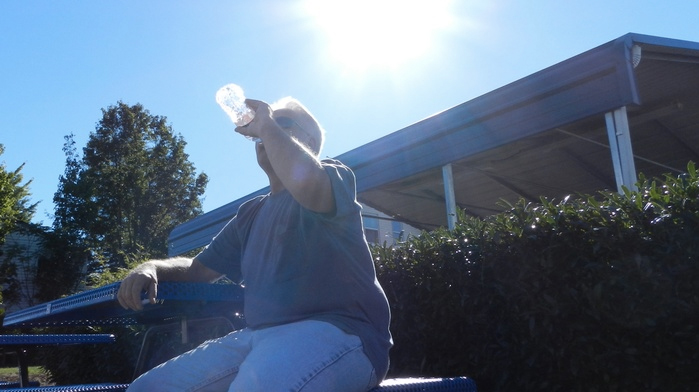
On a hot day in Portland, Oregon, Jack Sutton cools off while waiting for his car to be washed along 82nd Avenue. Research shows the area surrounding that major street is hotter and more polluted than other parts of the city (photo: Cassandra Profita)
SHANDAS: Take a right and an immediate left where that truck is turning.
PROFITA: Two weeks ago, they zip-tied 200 tiny air monitors to tree branches, street signs and telephone poles all over the Portland metro area.
SHANDAS: Let’s see if it’s still there.
PROFITA: Now they’re going back to collect them. To get the one on Mt. Tabor, they have to walk down a trail and into the trees.
SHANDAS: Oh, there it is. Should I pull the branch down?
PROFITA: The sensors look like smoke detectors.
RAO: OK, can you spot it? It’s on this big leaf maple.
PROFITA: But they’re measuring nitrogen oxide and nitrogen dioxide. Those are two common pollutants in cities that are also ingredients of ozone.
[CLIPPING SENSOR OFF THE TREE]
PROFITA: Shandas cuts the monitor off the branch and Rao puts it in a Ziplock bag. Later, she’ll take the device back to a lab. And she'll look to see how the air in a forested city park compares with the air in other city neighborhoods. Shandas says his research shows that places with more trees are cooler and have cleaner air. So trees seem like a good option for cities dealing with urban heat islands.
SHANDAS: It’s relatively easy to put trees in. It’s relatively hard to pull up concrete and roads, and it’s relatively hard to change buildings once they’re set up.
PROFITA: But even planting trees isn’t a simple fix. If you plant trees for shade and cooling in a canyon of downtown buildings, that actually trap air pollution from cars and trucks by reducing ventilation. So there are still a lot of questions about how many trees to plant and in what formation. Shandas says the new data they’re collecting in Portland should offer new insights.
SHANDA: So what we have is a couple of layers that tell us what’s the surface of really bad air quality and what’s the surface of really hot areas. We haven’t quite seen any place in the country, or dare I say the world that has actually been able to get at that resolution of information.
PROFITA: One day, Shandas hopes to have a kind of recipe for what makes urban heat islands hotter and smoggier – and what ingredients could be added to cool them off and clean them up. Studies show that for some people, that recipe could be a life-saver as climate change turns up the heat. In Portland, I’m Cassandra Profita.
CURWOOD: Cassandra Profita reports for the public broadcasting collaborative EarthFix. For more, check out our website at LOE.org.
Related link:
Check out the rest of the EarthFix series Symptoms of Climate Change here
[MUSIC: Janelle Monae “Primetime” from The Electric Lady (bad Boy Records 2013)]
CURWOOD: Coming up...discovering the secrets of success for coral reefs. Keep listening to Living on Earth.
[CUTAWAY MUSIC: Kneebody: “Lowell” from The Line (Concord Music Group 2013)]
The Spongy Secret of Coral Reefs
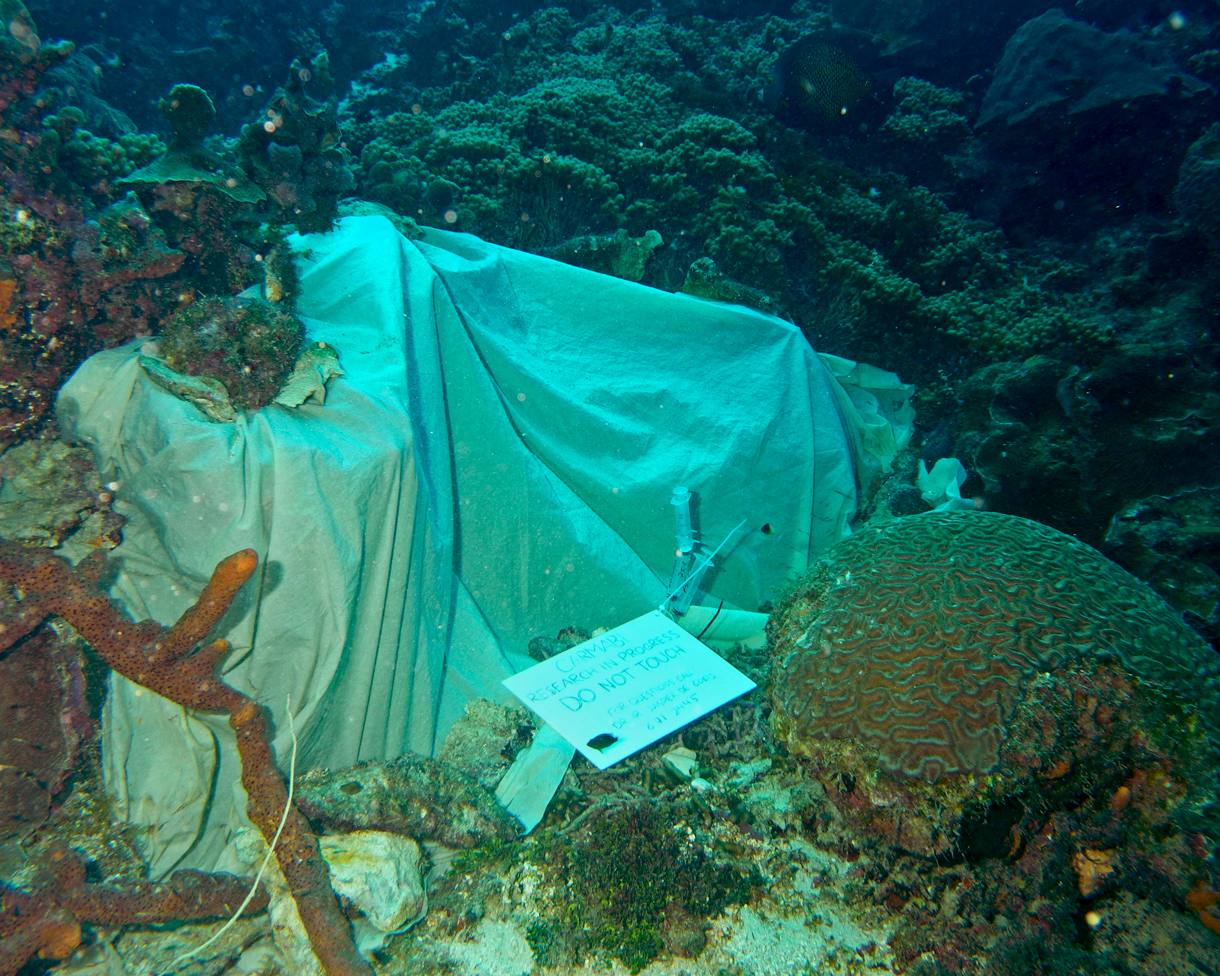
Closed-off cavity (in situ labeling isotope labeling study) (photo: Ben Müller)
CURWOOD: It’s Living on Earth, I’m Steve Curwood. Scientists have long marveled at the sheer diversity of life found on coral reefs. The clarity of the blue tropical waters means they are poor in nutrients, yet the reefs are the rainforests of the ocean, teeming with fish and coral. Now research from the University of Amsterdam in the Netherlands has found that a mostly ignored reef-dweller is playing a crucial role in feeding the other species that live there. Jasper de Goeij says the humble sponge is the simple answer to a fundamental question that has puzzled scientists for centuries.
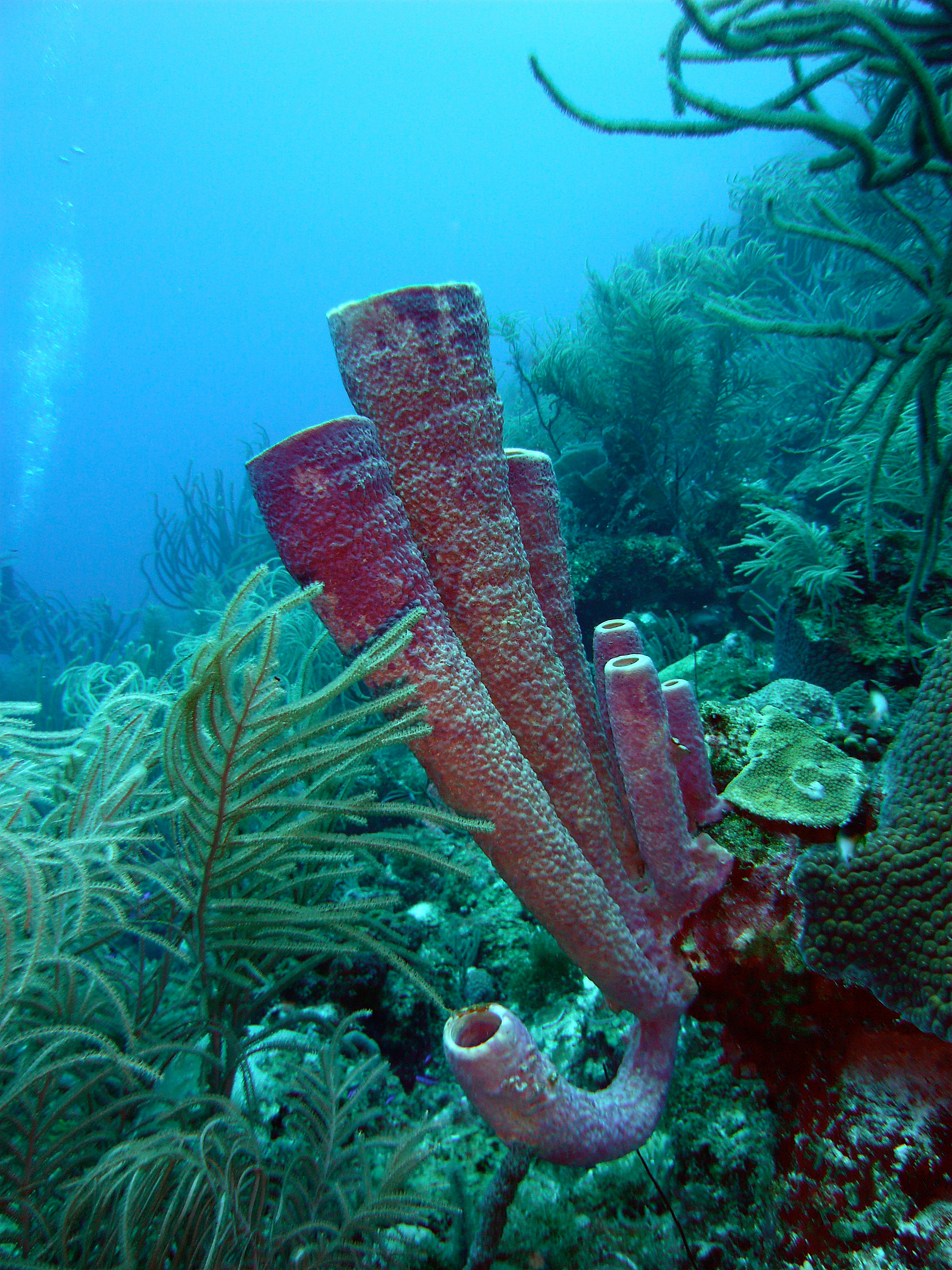
Sponges on reefs Curacao (photo: Erik van Bommel)
DE GOEJI: This question is actually one that Charles Darwin asked himself back in 1842 when he was discovering for the first time the beauty of coral reefs, and what he was thinking was, “How can a coral reef which is very productive and colorful and there’s a lot of fish and other species...how can that actually be such an ecosystem in the nutrient poor waters that the tropical seas are?” So in fact, a coral reef is sort of an oasis in the desert. Now we already knew that old energy and food that is on the reef is recycled constantly, but we didn’t know who did that and how that was done, and basically what we discovered is that sponges are sort of the key. They kind of recycle all the energy that is needed for a lot of organisms on the reef.
CURWOOD: So what’s the mechanism here? How are sponges able to make nutrients available to all the other creatures there in the coral reef?
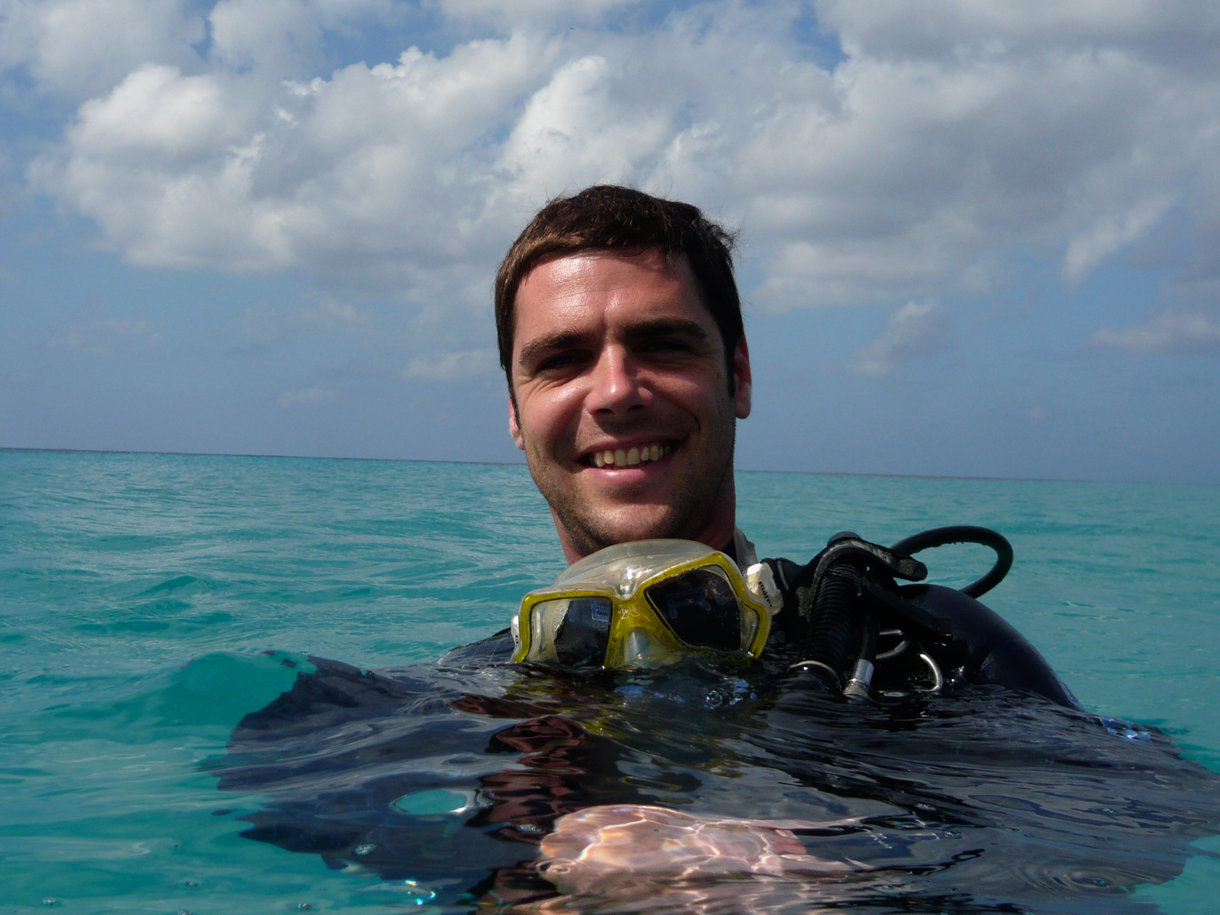
Marine biologist Jasper de Goeij (photo: Erik van Bommel)
DE GOEJI: So basically it starts out with what we call the primary producers. Those are the plants on the reef, like the algae and the corals themselves, and they can make energy from sunlight, just like the plants on land basically. And the energy they take from the sun, they leak also away in the waters as substances we call dissolved organic matters, so...like sugar. If you have a cup of tea and you put sugar in, you don’t see it anymore, but it is there.
Now the problem is that these dissolved organic substances, they cannot be taken up by most organisms on the reef. Sponges are the only ones basically that can take this potential source of energy and nutrients, and instead of growing very large by it, because there’s no real space anymore on the reef, everyone wants to be on the reef, so the sponges, they can grow to a certain size. They use this food to make new cells, so basically they want to keep young. They make new cells and old cells are shed into the water, and basically these old cells, or the detritus, is raining down on the reef and that is actually a nice food for other organisms.
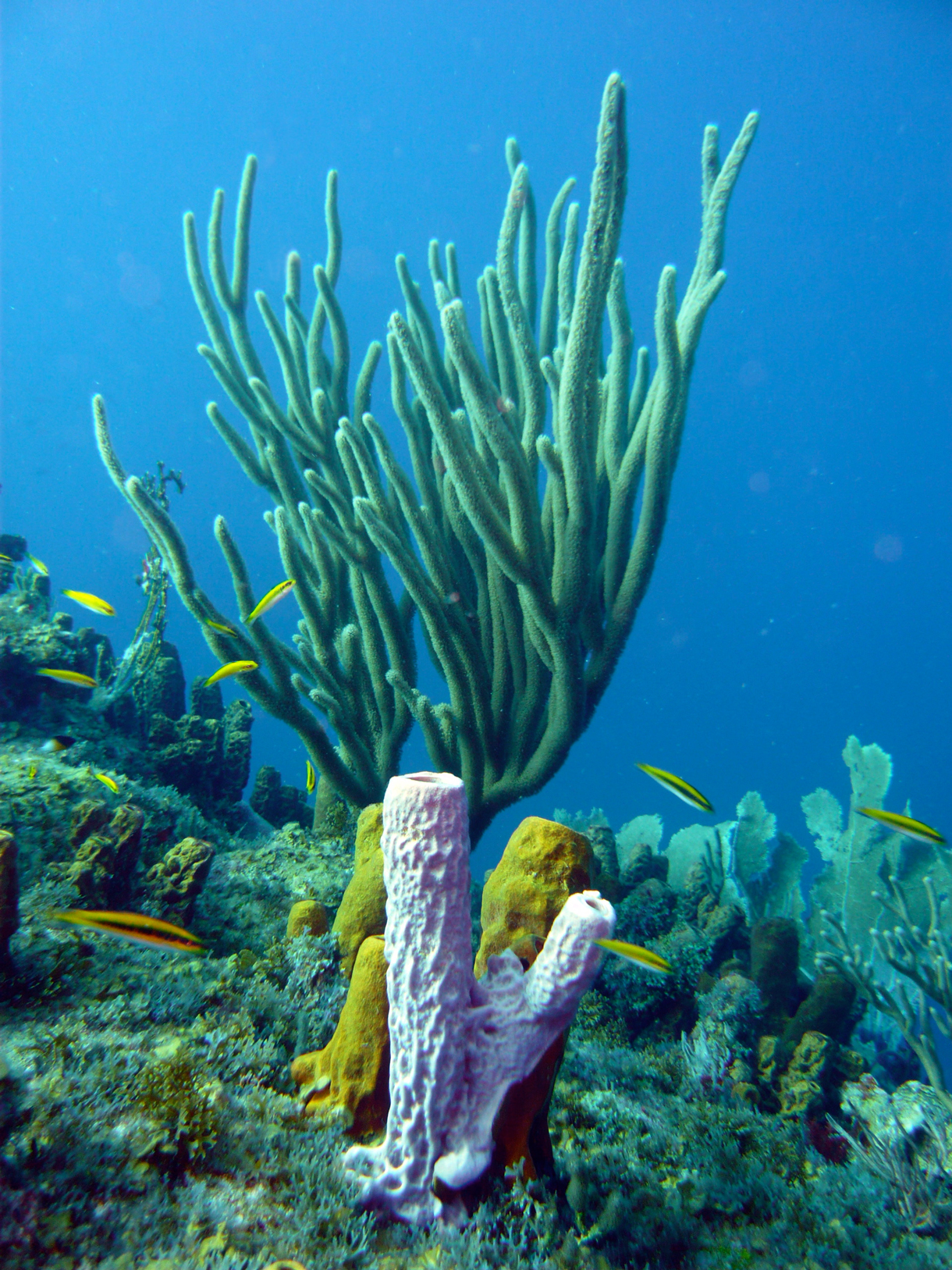
Sponges on reefs of Curacao (photo: Erik van Bommel)
CURWOOD: I understand you call this the “sponge loop”?
DE GOEJI: Yes, because, in fact, the old energy that is made by the reef, by all the corals and the algae, is converted to particles, to sponge detritus, or sponge poo, by the sponges. So it’s actually every bit of energy that is available is recycled through sponges in a sort of sponge loop.
CURWOOD: By the way, remind us exactly what is a sponge?
DE GOEJI: That’s a very good question. There’s many sponges. There’s about 15,000 species, and to compare, there’s only 5,000 mammals, and so there’s a lot more sponges than mammals on Earth. And sponges, in fact, are the first form of multi-cellularity. So basically, before the sponge about 700 million years ago, you only had single-celled organisms like bacteria and single-cell algae, and the sponge is basically an animal but it doesn’t have any organs or eyes or feet - it’s just a couple of cell layers.
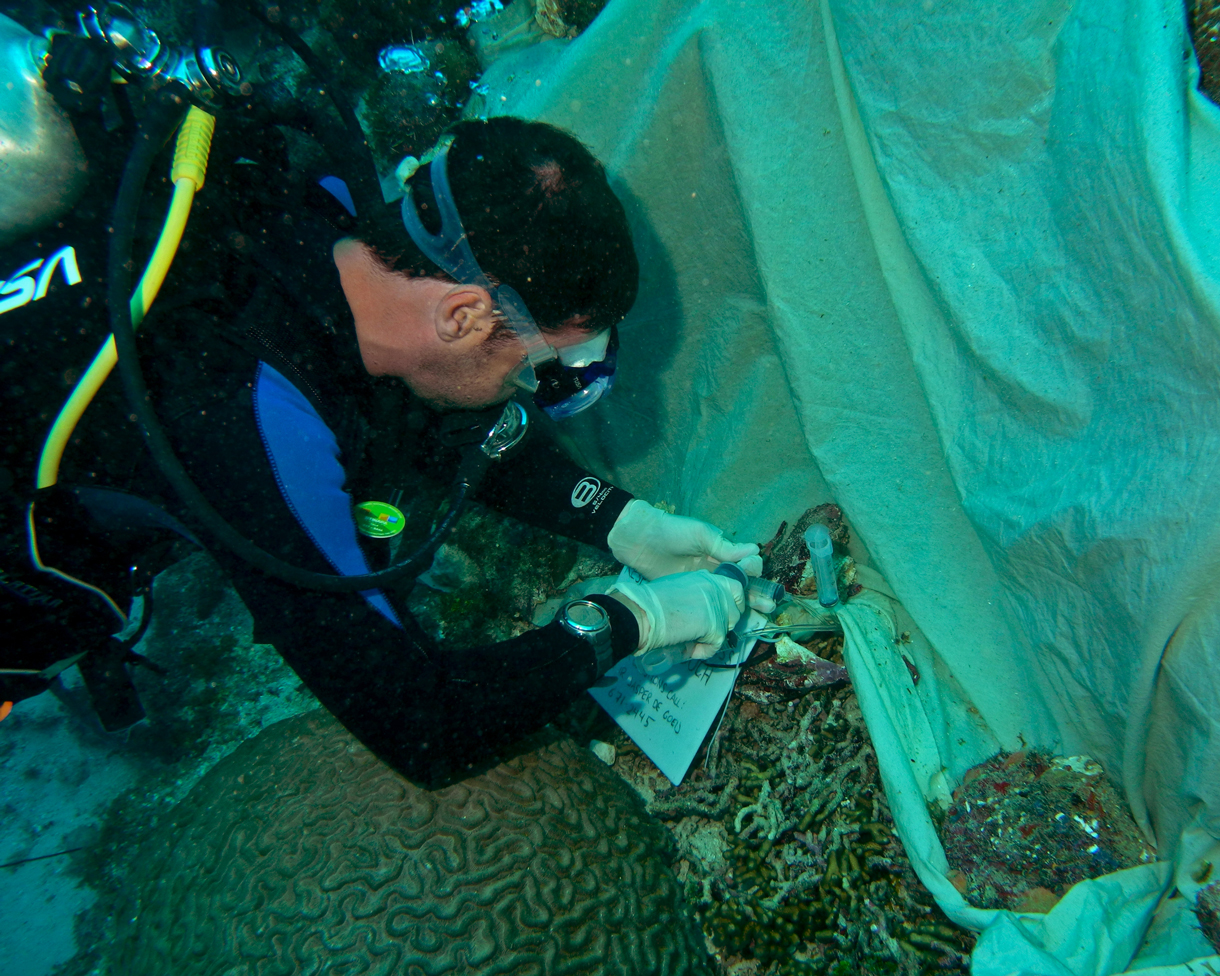
Jasper de Goeij sampling coral cavity (photo: Ben Müller)
CURWOOD: How are sponges faring around the world? What about global warming? What about ocean acidification?
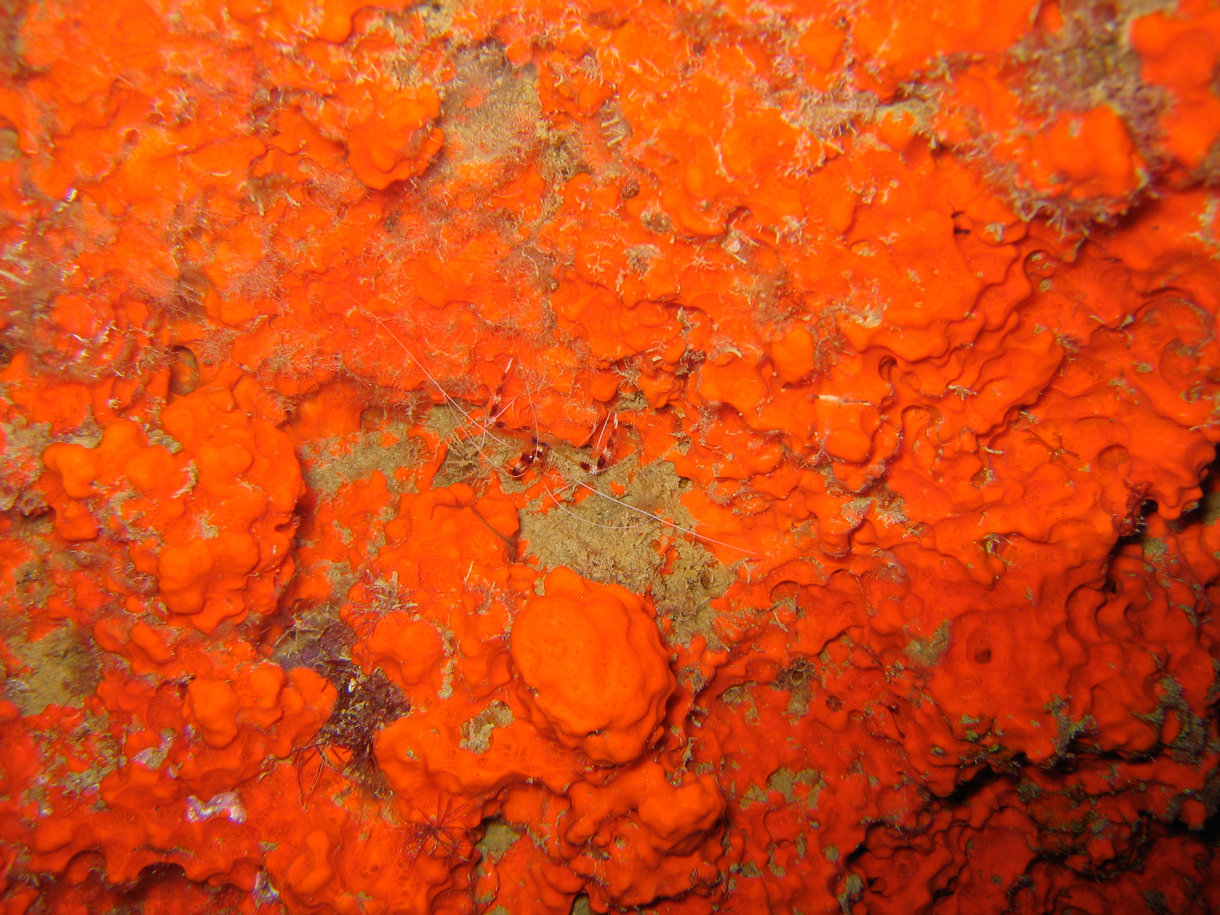
Bright orange encrusting cavity sponge (photo: Jasper de Goeij)
DE GOEJI: The global warming and ocean acidification will probably not affect sponges so much because the acidification of the oceans mainly affects organisms with a carbon skeleton like corals for example. Some sponges have that, but most of the sponges actually contain a glass skeleton, so I think that sponges will actually survive, and there is actually some people that believe that slowly, most of the coral reefs, if we don’t do anything, will change into sponge reefs.
So I think nobody should be too worried about sponges. I actually, recently, found a lot of sponges, in the Amsterdam canals. I don’t know if people listening to the radio have ever been to Amsterdam, but those are not the cleanest places, and they’re around for 700 million years. They’re very successful, and in fact you can find them from tropical reefs to mountain lakes to Antarctica. So I guess they are organisms that can adapt very well to their surroundings.
CURWOOD: How do you think your findings should shift how we think about protecting and conserving coral reefs?
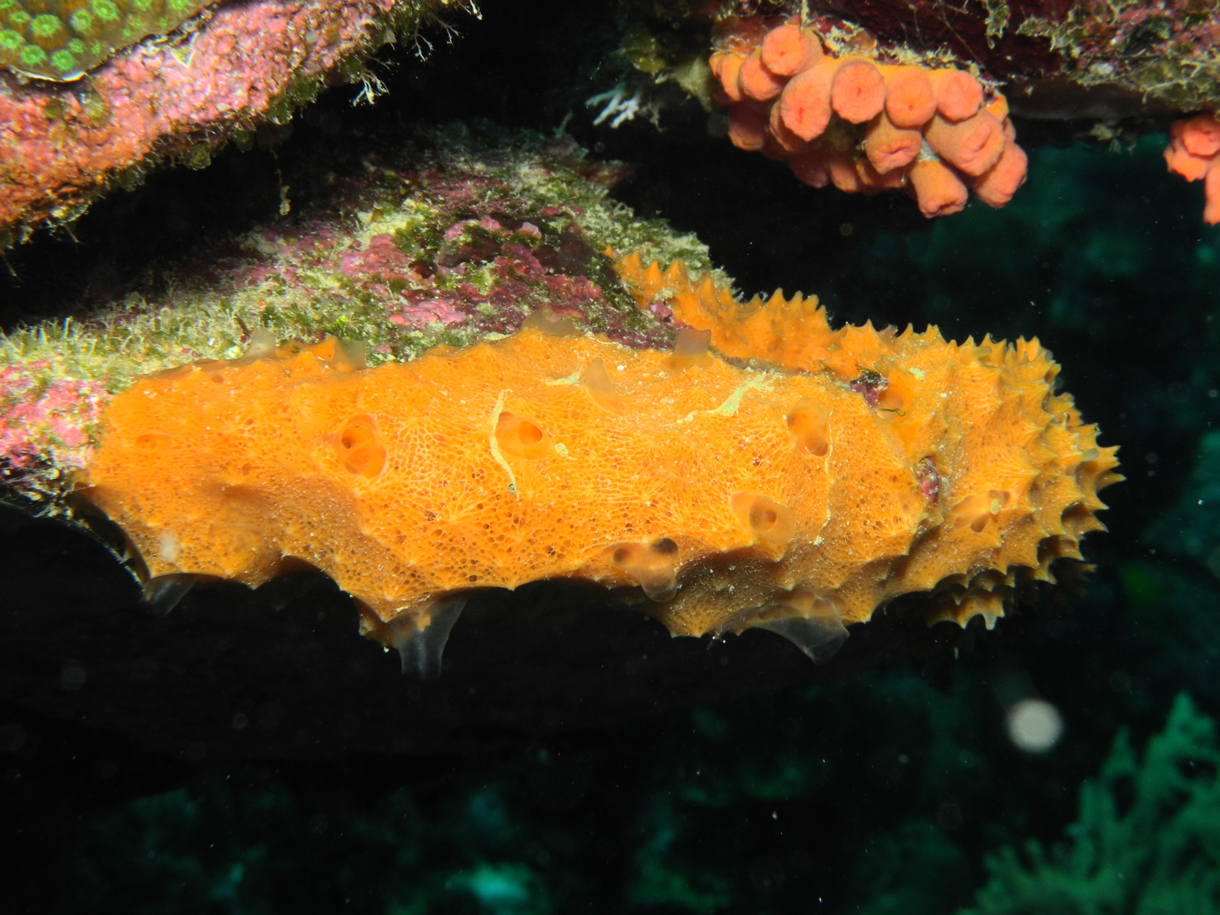
Scopalina ruetzleri (other model sponge) (photo: Jasper de Goeij)
DE GOEJI: It is unfortunately so that coral reefs are not doing that well around the world. They’re rapidly declining because of climate change and human impact, and it’s very important to conserve them because they’re important socioeconomic areas for local communities - island communities. Now the whole coral science is pretty young, only 50, 60 years we know how to scuba dive, so we know how to go down there and do research, and then I think the obvious thing to do is start by what you see in this. At first we studied the corals, and then the fish and the algae, and I think that sponges were not considered just because they’re not so obvious as the corals and the fish. But to conserve a system, you need to understand it, and now we know that sponges are important. We really have to include them in management conservation programs.

Close-up encrusting sponge Halisarca caerulea (one of model species), including detritus on top of sponge (photo: Jasper de Goeij)
CURWOOD: Jasper, what do you hope comes out of your research?
DE GOEJI: Well, I’m always interested in the fundamental science. I like to know how an ecosystem like the coral reef works because it’s just a complex and beautiful system, but I also like to do something with the knowledge. So, for example, use the concept, hey, you know how a coral reef works, you basically know how a very productive ecosystem works without producing waste. So can we learn from that, can we use that as concepts for sustainable agriculture, for example. So I’m very interested also in applying some of the science that we do.
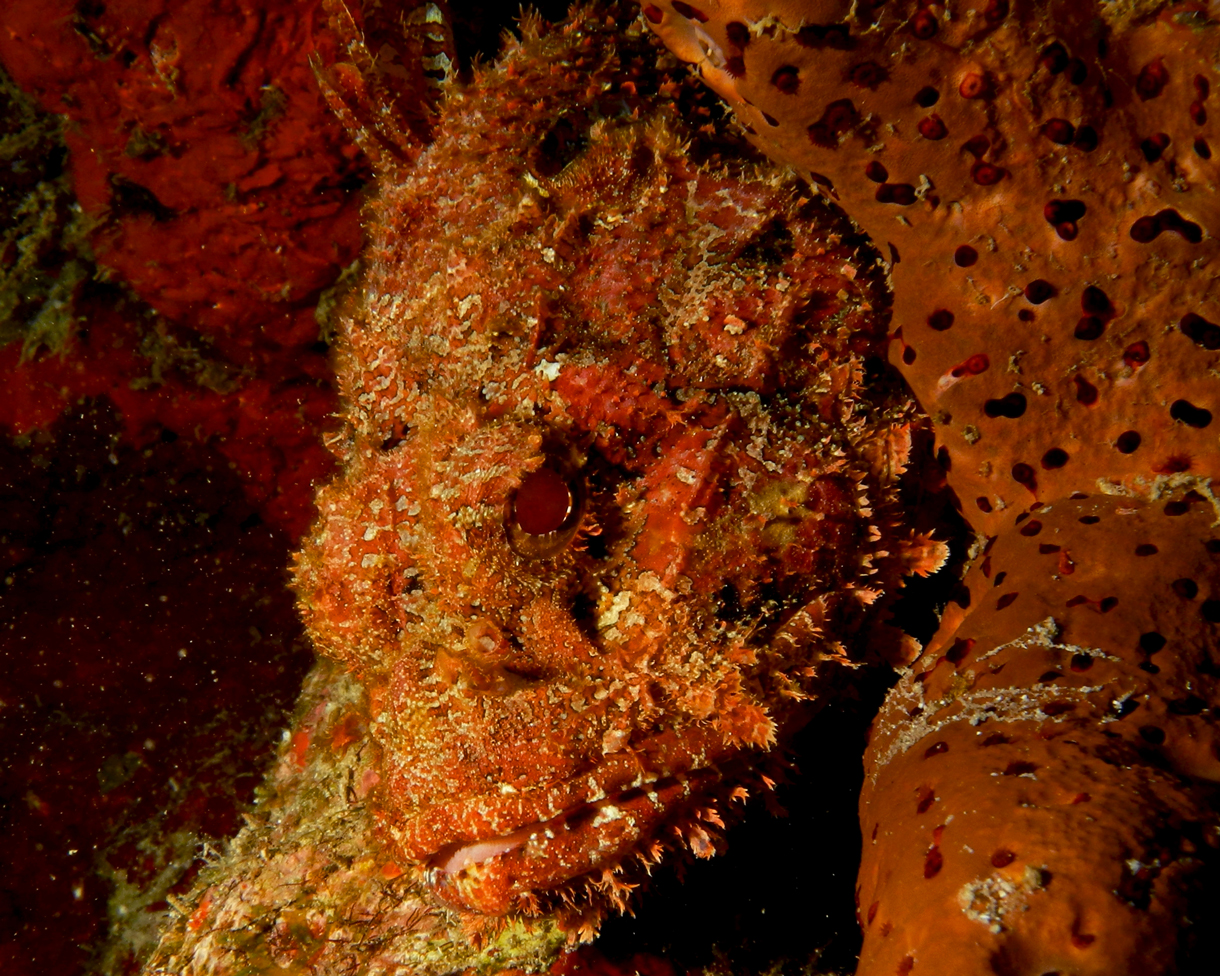
Stone fish hiding behind a sponge (photo: Ben Müller)
CURWOOD: Jasper de Goeij is a Biologist at the University of Amsterdam. Thanks so much for taking this time.
DE GOEJI: Thank you very much.
Related links:
- Check out Jasper’s website
- Read the paper in Science
Copepod Love
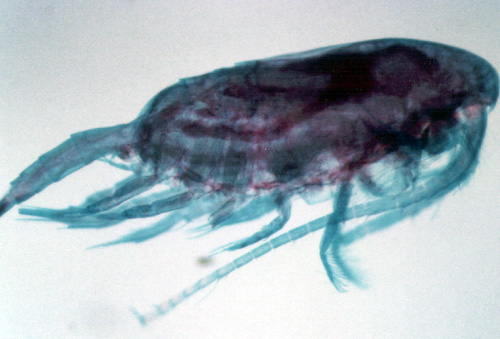
CURWOOD: We stay with the watery and humble, indeed, in this case, even more minute for our next story. Like the question of how coral reefs can be so productive, the mystery of how the littlest creatures at the bottom of the food chain actually manage to track down suitable mates has been a subject that intrigues scientists. Ari Daniel has been following scientists who have been finding some clues, for another in our series Small Matters, which sweats the small stuff.
DANIEL: Finding a mate isn’t easy...even when the backdrop to your wooing is as picturesque as the Damariscotta River Estuary. Here, halfway up the coast of Maine, pine trees run right down to the salty shoreline. It’s in this water, 30 feet down, where our love story begins.
[SPLASH]
DANIEL: Rachel Lasley-Rasher, a biologist at the nearby Darling Marine Center, tosses a cone-shaped net into the water.
LASLEY-RASHER: The mesh openings are very, very tiny.
DANIEL: That’s because what she’s trying to catch - the lovers in our story - are copepods.
LASLEY-RASHER: Copepods are small crustaceans, so if you see one under a microscope, it looks really similar to maybe a small shrimp.
DANIEL: They’re as small as a period on a page. And yet their importance is huge - entire marine food webs depend on them.
LASLEY-RASHER: Everything wants to eat you when you’re a copepod.
DANIEL: Baby fish, tiny shrimp….. Lasley-Rasher hauls up the net by hand and pours the contents of the enclosed, tapered end into a bucket.
[WATER SPLASH]
LASLEY-RASHER: And see what we got. Yeah, I think that’s a Temora.
DANIEL: A small brown speck, a Temora copepod, glides through the bucket water. And here’s the question: in the vast volume of water where copepods live, how does a tiny male speck find a tiny female speck to make more copepods, to keep the food web going? This basic question of copepod courtship kickstarted Lasley-Rasher’s graduate work back when she was a student at the Georgia Institute of Technology. She used to pack up copepods from this estuary in Maine, and ship them overnight to Atlanta for closer examination in this lab – the lab of her former supervisor.
YEN: My name is Jeannette Yen. I’m a professor of biology at Georgia Tech.
DANIEL: Yen didn’t set out to study copepod mating in her lab. Instead, she was using a microscope camera to visualize how different kinds of copepods eat one another - to get at understanding the complexities of the aquatic food web.
YEN: You know, it’s in the dark. And we have a nice, beautiful green laser beam illuminating the copepods - and we see all the guys going around. And all of a sudden, we saw a little guy zoom up, and they spin around in a dance.
DANIEL: It happened again and again - one copepod closing in on another copepod, and then the two of them pirouetting through the water. But this wasn’t an interaction between a predator and its prey. It turned out these two copepods were a mating pair - a male pursuing a female.
YEN: He speeds up, speeds up, speeds up - grabs her! And we found out that he was following her trail exactly.
DANIEL: It happens in a flash on the screen, but it’s still obvious - every turn, every arc she makes in the water, he retraces. It’s not a beeline approach.
YEN: So then we played around this - we made this stuff called copepod tea where we put all the females in a cup of water and let them perfume it.
DANIEL: Then they took the females out, and dripped the perfumed water into a new container holding only males.
YEN: And he still followed the trail, so we knew it was a chemical.
DANIEL: In other words, as the female swims, she’s leaving behind a tiny filament of scent in the water that lasts for a good ten seconds. And once the male bumps into it, he races along the trail to find her. That filament is only half the length of a toothbrush, but that’s still 100 times bigger than a copepod.
YEN: So that increases the encounter rate, and that’s why this is a survival tactic for these copepods.
DANIEL: Now, identifying this copepod-come-hither molecule has proven somewhat difficult. The lab needs at least a few million individuals to distill enough of the compound to figure out what it is. The most they’ve managed to collect so far is a few thousand, and that took five people working for a week straight.
Still, knowing that copepods produce and respond to a chemical like this is yielding insights into their evolution. Yen says this molecule may help accelerate how quickly new copepod species arise. A simple change in the structure of this chemical could lead to a radically different perfume. So in only a matter of thousands of years, instead of millions of years, you could have two new copepod species on your hands - one using the original scent, and one using the new scent. And it would all be driven by chemistry.
LASLEY-RASHER: Yeah, chemistry is everything to them.
DANIEL: Back up in Maine, Rachel Lasley-Rasher looks out at the estuary. Beneath the surface, many millions of female copepods thread the water with tiny chemical trails.
LASLEY-RASHER: I just like thinking about how they’re experiencing their physical world because it’s so counterintuitive to our human world. I mean, they’re really these millimeter-sized organisms swimming around blind tasting their world, and I just find that kind of fascinating.
DANIEL: Attraction happens at all scales – between granular animals in a watery world, yes, but also for scientists – human beings with big curiosity, drawn to the tiny things all around them.
For Living on Earth, I’m Ari Daniel.
CURWOOD: Our series, Small Matters, is produced by the Center for Chemical Evolution, with support by the National Science Foundation and NASA.
Related link:
Check out the rest of the Small Matters series from Ari Daniel
[MUSIC: John Scofield “Snake Dance” from Uberjam Deux (Savoy Jazz 2013)]
Bob the Cat

Bob the cat raises his chin on command (photo: Mark Seth Lender)
CURWOOD: From the tiniest of creature in nature to a relatively small yet formidable member of the cat family - the bobcat. Despite its size, a bobcat can take down game up to eight times it own body weight. And though bobcats range far and wide, they're seldom seen. If you do see one, as writer Mark Seth Lender notes, you might almost mistake it for a house cat. Almost, but not quite.
LENDER: Bob the Cat lies in the sun, curled as any cat would. And stretches… And moves into the shade, the whole short length of him. He will purr for you on command to demonstrate his blood pressure is where it should be and also growl, deep in the throat, and scare you but good if you're not expecting it. Then raises his chin when you say, “Smile for me Bob, smile!” so you can see there are no flees or mites on him (not that they would dare). For these favors you reward him with raw meat; and might be tempted to stroke his head or scratch behind his ears.

Bobcats are fearsome hunters: see those teeth! (photo: Mark Seth Lender)
Not recommended.
His looks are no different from a Marmalade tabby cat-napping through the day, except for those little ear tufts and his bobbed tail. And the square of his shape; all muscle, close to the bone and dense as the stump of a tree.
Fifty years ago when I was kid, in Vermont for the first time, I met a cook named Lucille. She had a dairy farm, back when farms were going under at 10 percent a year; making other people’s meals was how she held on. She was in the kitchen, talking with Walter, another farmer. He’d been out deer hunting, he said, saw a bobcat not more he thought than 25 pounds drop from a tree, and rip the throat out of a running 12 point buck.
And I’ve remembered that; which is why out of respect not fear I kept my paws to myself, and let Bob sleep, and I still have both my arms.
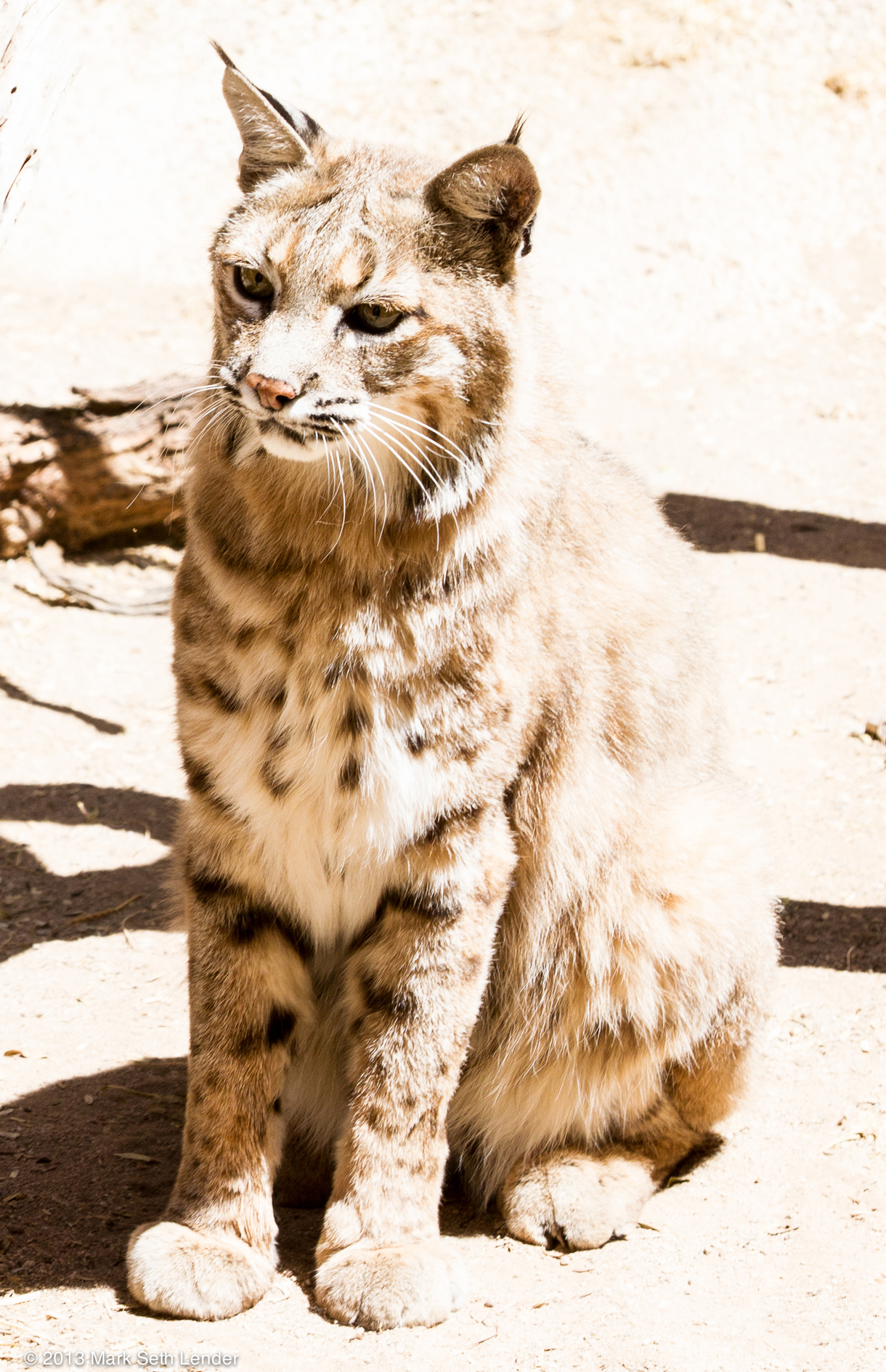
He might look like a tabby cat - but don't be fooled (photo: Mark Seth Lender)
Lucille died some years back, and that three hundred acres of hers is long gone. Just weeds and run-down doublewides now. But if you take a moonlight stroll out from the back of her place and into the woods they call the Burn, where men have gotten lost and never been found, a pair of green eyes will be watching you. From the cave to the southern side of Hooker Mountain… Or the shore of Peacham Pond. Oh yes. There’s bobcat out there, and will be. Long after we ourselves are long gone, and forgotten.
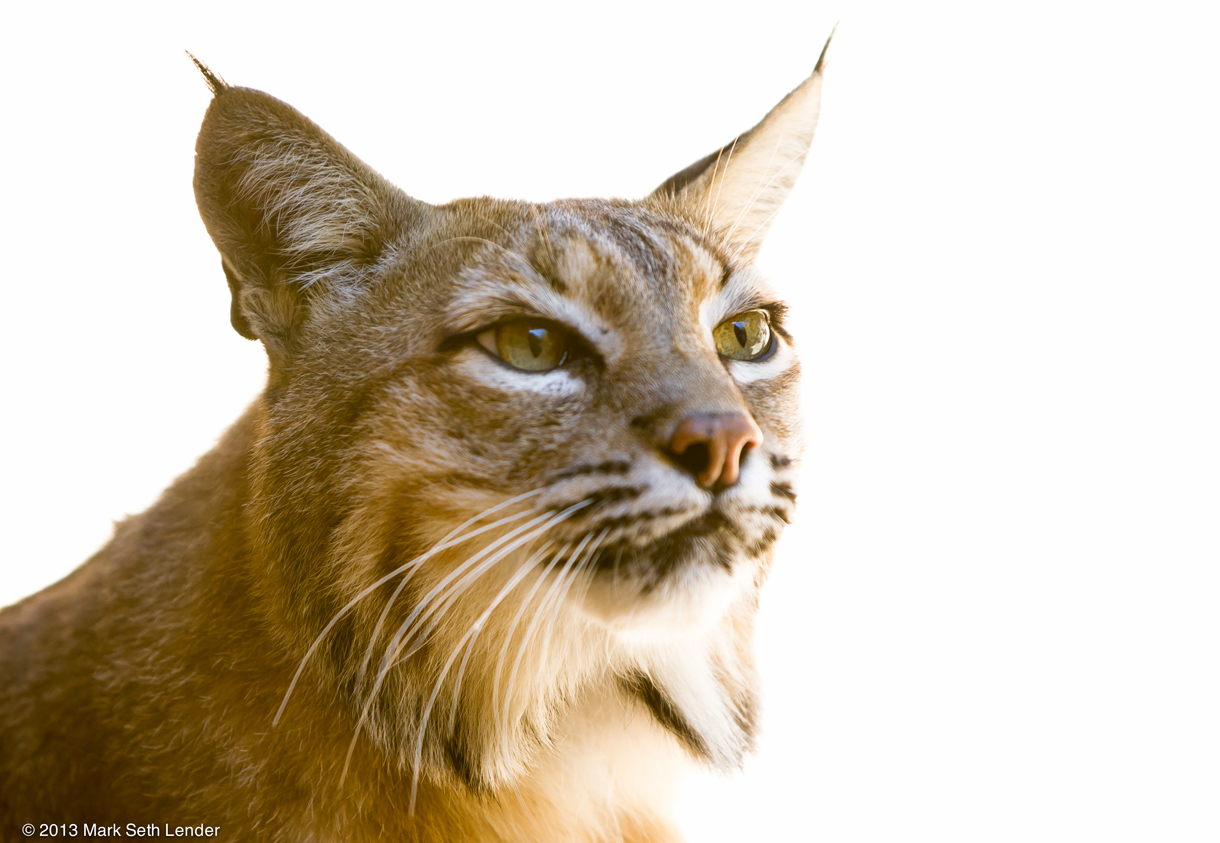
A pair of watchful green eyes (photo: Mark Seth Lender)
[BOBCAT GROWLING]
CURWOOD: Mark's chance to meet and record Bob the cat came thanks to the Sonora Desert Museum. To see some of his pictures, slink on over to our website, LOE.org.
Related link:
Check out more of Mark Seth Lender’s writing and photographs on his website
[MUSIC: Janelle Monae “Suite V: Electric Overture” from The Electric Lady (Bad Boy Records 2013)]
CURWOOD: Coming up...astrophysicist Neil de Grasse Tyson takes us to the stars, through Hollywood and beyond. That’s just ahead on Living on Earth - stay tuned.
ANNOUNCER: Funding for Living on Earth comes from the Grantham Foundation for the protection of the environment. Supporting strategic communications and collaboration in solving the world’s most pressing environmental problems; the Kendeda Fund, furthering the values that contribute to a healthy planet, and Gilman Ordway for coverage of conservation and environmental change. This is PRI, Public Radio International.
[CUTAWAY MUSIC: George Duke “Let’s Roll” from Face The Music (Big Piano Music 2002)]
Gravity According to Tyson
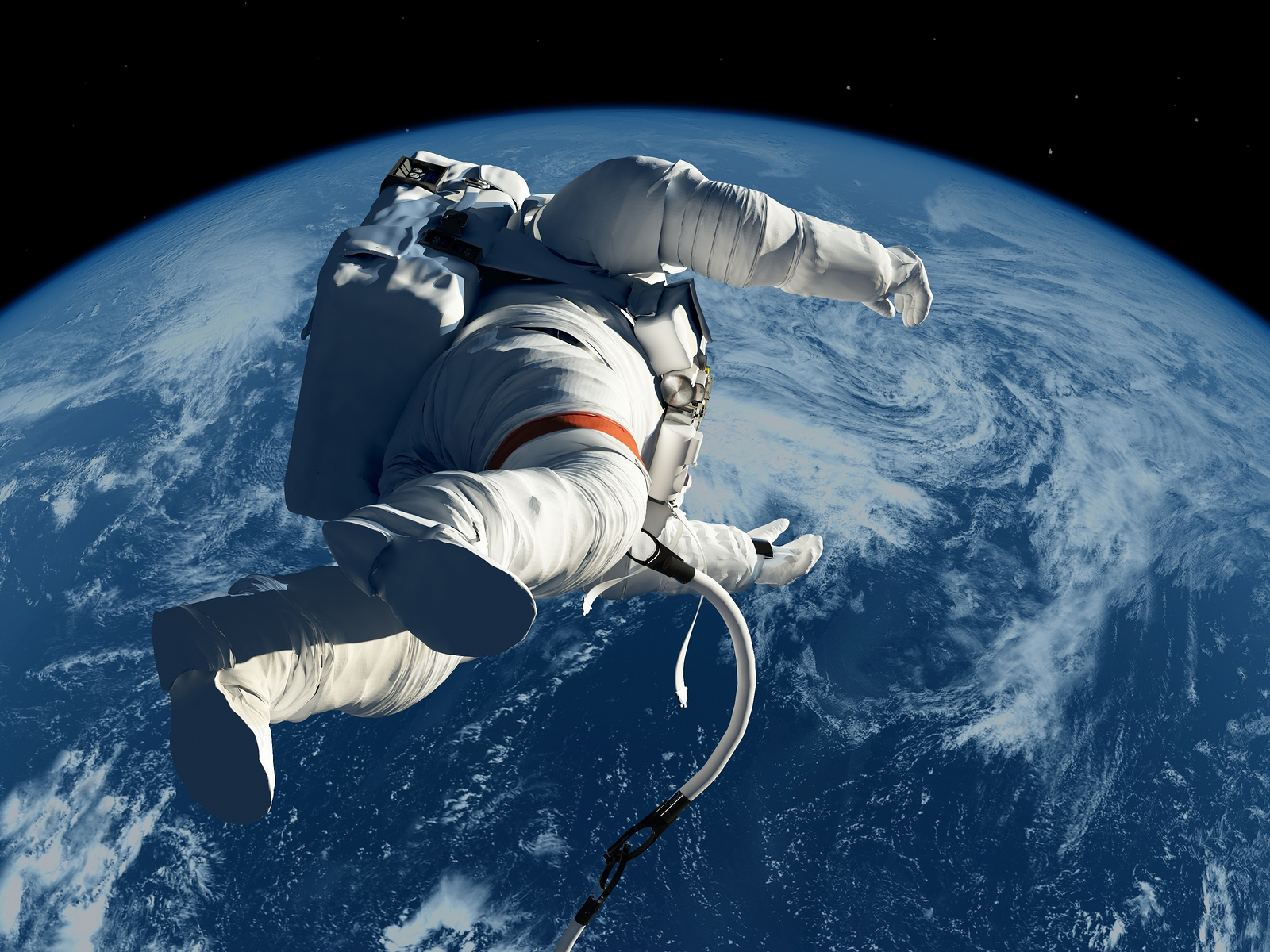
Nearly the entire movie is shot in zero gravity (photo: bigstockphoto.com)
CURWOOD: It's Living on Earth, I'm Steve Curwood. One of the most popular films to hit the screen recently is Gravity, which features a couple of astronauts - played by Sandra Bullock and George Clooney - untethered in space and bombarded by space junk.
[MOVIE CLIP]
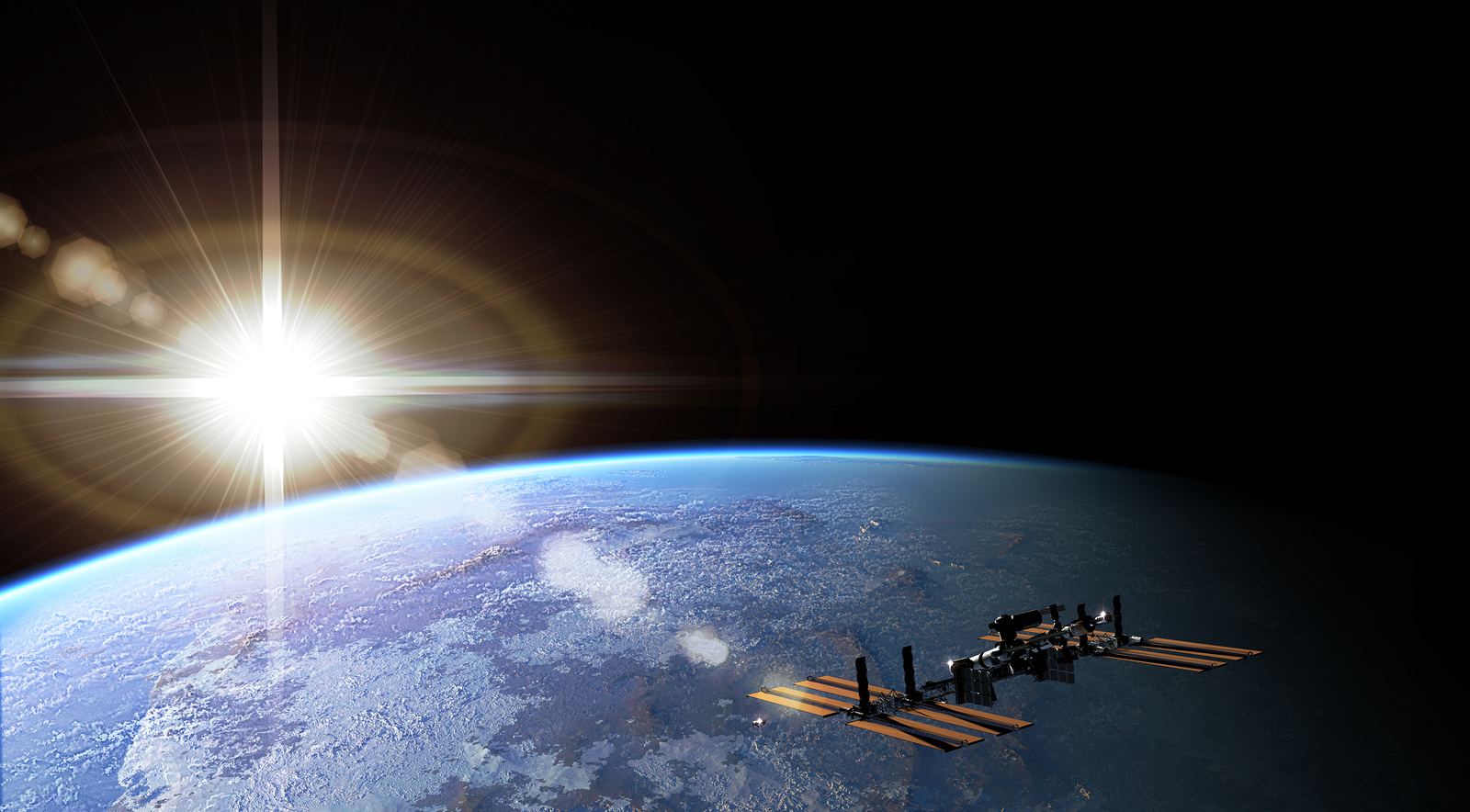
In the movie Gravity, lost astronauts must make their way to the international space station (photo: bigstockphoto.com)
CURWOOD: Well, besides proving popular, this movie received special attention from the fraternity of astrophysicists - who, as experts often will - found some of the depicted science to be a bit wobbly. It also gives us an occasion to call up astrophysicist Neil de Grasse Tyson, the director of the Hayden Planetarium in New York - and one of those scientists who found some nits to pick in the film. Neil, it’s been a while. Welcome back to Living on Earth.
TYSON: Thank you. It has been a while. Yeah you don't call me, you don't text, you don’t write, where’ve you been?
CURWOOD: Well...
TYSON: A lot has happened in the universe since we last talked.
CURWOOD: You know, what can I say, um...

Astrophysicist Neil Degrasse Tyson (Photo: Chris Cassidy/ Casspix.com)
TYSON: [LAUGHS]
CURWOOD: Things are moving at warp speed sometimes, Neil.
TYSON: ...or faster.
CURWOOD:...or faster. [LAUGHS] So you’ve got yourself embroiled in a bit of a row over this new movie Gravity.
TYSON: You know, I’m just...what’s a scientist to do?
CURWOOD: Yeah, I know. [LAUGHS] Well, it all began when you fired off a few tweets questioning some of the science in the movie.
TYSON: It was like a dozen tweets. I could have sent 100 tweets telling everyone what they did right. I could have done that, but people presume that because I cited a few scientific faux pas that all of a sudden I didn’t like the movie, I railed on the movie and all that. No, I thought the movie was fine. I mean, I’ll take any space movie I can get these days. [LAUGHS]
CURWOOD:[LAUGHS] But what did they not quite get right?
TYSON: You know, just little niddly things. Like I said, people...it became a mountain when it was intended just to have fun. I hit the trifecta of the Today Show, Brian Williams, the NBC Nightly News and it was referenced on weekend update on Saturday Night Live. So I thought that people were overreacting really, but...
CURWOOD: [LAUGHS]
TYSON: So a few things. OK. Let’s start simple. So Sandra Bullock’s hair, as well as they did all the rest of the zero G representations, her hair didn’t stand up on end...or maybe she used too much mousse? It looked a little bit like a wig actually, but in any case, you have everything else floating around and her hair just stuck to her head. I thought that was a little weird, but you know, you can let that one go.
CURWOOD: What about her tears?
TYSON: The tears. There’s been some discussion about that because there’re some astronauts on the space shuttle who did some tear experiments to see what would happen if you cry. And so… the surface tension of a tear...this is what keeps a droplet of water almost spherical on a clean surface, you know, like if you have a smooth marble surface and you drop some water on it, the water doesn’t spread out across the entire surface, it just stays in a little ball. So that, what’s called surface tension, it’s a chemical phenomenon on the surface of all liquids so it sticks to things, even to itself. So if you try to tear, it’s likely that the tear will stay on your eyelash or your...the upper or lower eyelashes...or stick to your cheek and just sort of stay there. And so some people criticize that but I didn’t have an issue with that because she’s about to die, or she thinks she’s about to die, and so she might be tearing more than the astronaut who did the experimenting in space.
[LAUGHS]
CURWOOD: [LAUGHS]
TYSON: So I think you can cut a tear cleanly with a good blink, and then the tear floats away. I think that was the most poignant scene in the whole film, and so I give that two thumbs up for capturing an intimate and sensitive zero G moment.
CURWOOD: But there was some confusion about the various low Earth orbits out there.
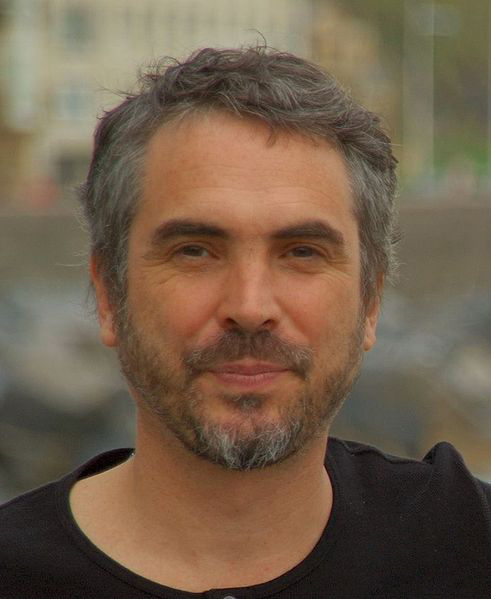
Gravity director, Alfonso Cuarón (photo: Mario Antonia Pena Zapatería)
TYSON: Well, yes, so...I don’t know if this is forgivable, but there they are fixing the Hubble telescope and stuff goes wrong and so they say, “Let’s just go to the space station. There it is!” And they just jet-pack to the space station. The Hubble orbits at 360 miles up and the space station orbits at two-thirds that height, 230 miles up. So first of all, the space station would be below them, not above them, and its closest it’s 130 miles, at its closest. You’re going to jet-pack for 130 miles? Most of the time, you can’t even see it. Earth has a huge surface area. So just to jet to that, and then, “Oh, there’s the Chinese space station. Let’s go there.”
You think that everything’s in view and accessible by jet-pack, and so this is just completely unrealistic, and the orbits don’t even match. The space station orbit is tipped, I think around 50 degrees relative to the equator, and that’s so that it can go over the launch location in Russia where they send cosmonauts to the space station and now including the American astronauts because we’re hitching a ride on the Soyuz because we don’t have a space shuttle. I’m sorry, we’re not hitching, we’re buying the seats to the space station! So that orbit is tipped in that way, whereas, Hubble has an orbit that matches Cape Canaveral. That’s a whole different tilt. He didn’t think that one through. Or maybe he did and ignored it, and that’s possible too.

During the government shutdown, NASA was almost completely closed (photo: NASA)
CURWOOD: And yet you love this movie.
TYSON: I enjoyed it. Let me not say love it. I enjoyed it, and I thought it was a nice...99 percent of the movie is in zero G...has anyone done that before? I don’t think so. So you can’t fault someone for not getting everything perfect if they do something that no one has done before. So in that regard, I fully applaud Alfonso’s efforts, the director.
CURWOOD: But next time, if he calls you as consultant, he won’t get this wrong. [LAUGHS]
TYSON: Well, I don’t claim total infallibility. Keep in mind, you only see what’s wrong, after they got everything right. Even the movie 2001:The Space Odyssey from 1968, which gave so much attention to detail of zero G, got a couple of things wrong. There’s a point where the guy’s sipping liquid out of a sack in zero G, and then he stops sipping, and the liquid drops back down the straw. Well, it wouldn’t do that if you’re at zero G. It would just stay there in the straw. They can’t think of everything. I think, I’m complementing the film by citing the things they got wrong. I don’t give a list of things that Star Wars got wrong, I’m sorry. [LAUGHS]
CURWOOD: [LAUGHS]
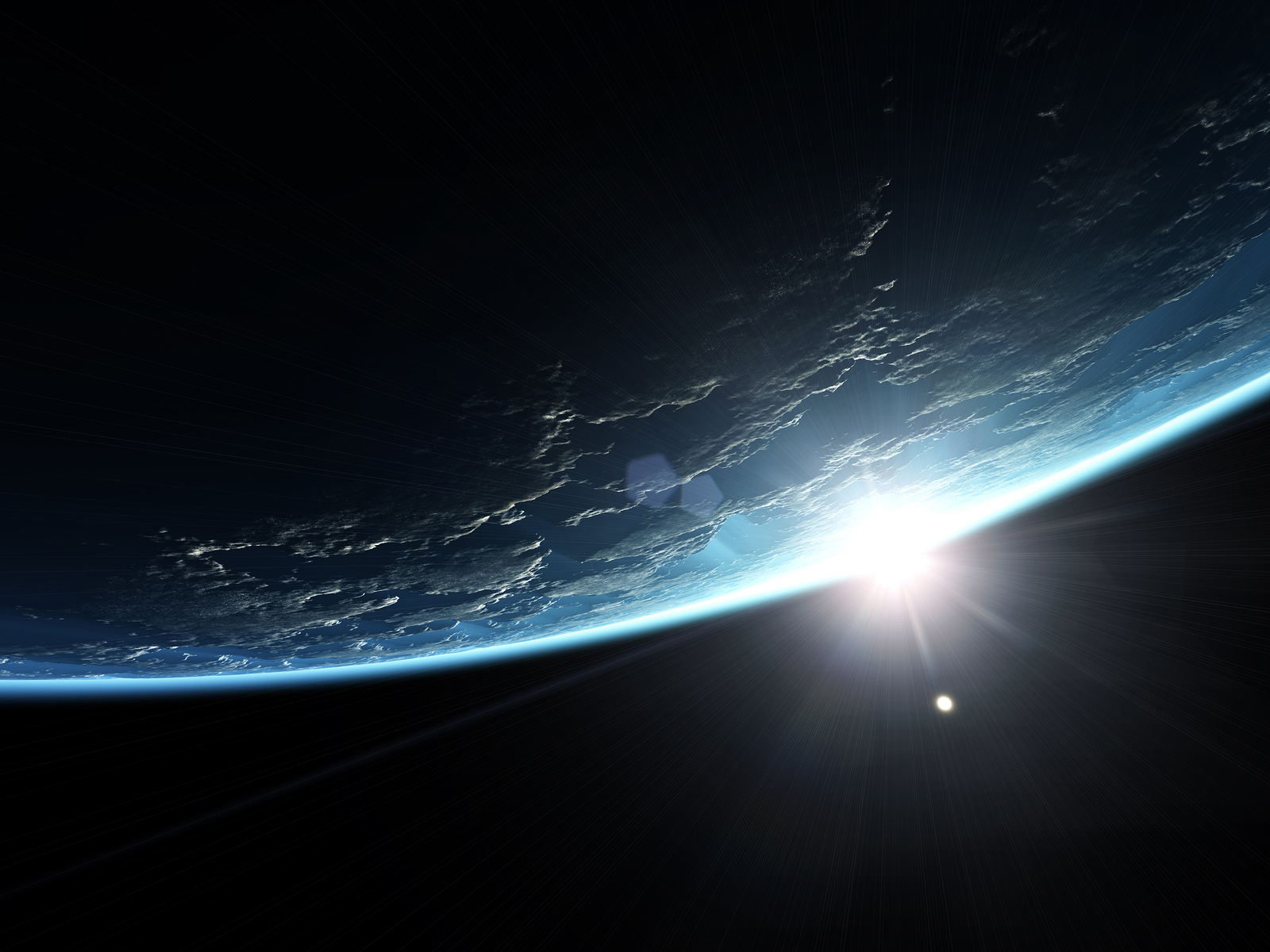
The sun rising over the edge of the earth (photo: bigstockphoto.com)
TYSON: Some movies are not worth that effort. What you do with Star Wars is rather than say what they got wrong, you mention a couple of things that it got right. Right? So if the movie makes no attempt to be scientifically accurate, you find the things they got right, and then you applaud that. In Star Wars, the little double sun was a planet orbiting a binary star system. That was kind of cool, you know, they thought about that because there are binary stars out there, but I think many people, until that movie, didn’t know there are star systems where there are multiple stars orbiting one another - two or more stars. So, that’s something they thought about and they put it in the film. That’s good. I like that.
CURWOOD: So the movie isn’t the only thing about space in the news. A spacecraft called Cassini detected propylene, and that’s what makes plastic, I think it’s number five on the recycling label. They found this on Saturn’s moon Titan. What do you make of this?
TYSON: Yeah, well, Titan is cool. It’s almost like an early Earth, but just at a whole other range of temperatures. So we think of Earth...there’s a temperature that allows liquid water and then the rocks are solid, and the air is oxygen and carbon dioxide. So we have this expectation for what is solid, what is liquid, what is gas. When you go to the moon Titan, Titan is very cold. It orbits Saturn, Saturn’s very far from the sun so the heat sources are very low, but at the very low temperatures that it is, different things are gas, different things are liquid, different things are solid.
For example, the rocks on Titan are ice, which is frozen water. The liquid on Titan is lakes of methane. And so everything is different, but when you’re at a cold temperature, atoms like making molecules because they move really slow, and then they nestle next to another atom, and you can build these huge interesting molecules. If everything is hot, the heat energy breaks apart all your molecules, and there’s a point, there’s a temperature above which, there are no molecules and you just have atoms. Then you can start stripping electrons from atoms and then everything would ionize like hot stars, so like the center of the sun, there’s no atoms, and they’re all stripped and there are no molecules. So on Titan you can make all kinds of complex molecules, and so sure, start tallying what’s there.
CURWOOD: So this could be a shopping mall for those of us here on Earth. I mean, let’s say we run out of oil, maybe we get our plastic from space?
TYSON: [LAUGHS] Yeah, I mean space is vast, and has many more opportunities to make things than we do, so there’s an old saying that unless it’s absolutely prohibited by the laws of physics, then it’s a certainty that it’s out there. [LAUGHS]
CURWOOD: So it’s interesting that the newest Mars Rover, named Curiosity, discovered water in the Martian dirt, but no methane.
TYSON: Yeah, so there was some early evidence that there might have been methane on Mars. What’s fun to think about, regarding methane, is that methane is not a particularly stable molecule. In other words, if Mars had methane when it formed, it wouldn’t have it today because it’s chemically active. So if you see a constant source of methane in a place, we know it’s what they call biogenic processes - life-based processes that create methane - among them is what goes on in your lower intestine, especially farm animals, and this accounts for a large number of the flatulent volume that emanates from cows. So we know that life can make methane. So if you have methane emanating from Mars and it’s persistent, it can force the question, is there active life - biogenic life, biogenic processes - going on in the buried strata of the planet? And so no methane says maybe not, certainly there’s no farm animals!
CURWOOD: But wait a second. Let’s go back to Titan. There’s all this methane. There’s rivers of methane on Titan so I mean is there a lot of life down there that we have no idea about?
TYSON: [LAUGHS] Titan still needs extensive investigation. We just don’t know how you would make life that doesn’t involve liquid water. That’s really what it comes down to. We’re not creative enough to figure that out. We like, actually we require, liquid water. We as not just humans but all life on Earth. So when we look for life elsewhere in the solar system, we hold up the requirement that water is there, otherwise we consider it low likelihood of finding life. It would be low likelihood of finding life as we know it. It could be life that doesn’t require liquid water - maybe it just requires liquid.
So Titan, with liquid methane, maybe there’s life forms that thrive on liquid methane. The liquid methane is the vehicle to carry nutrients and other things through the life form that could possibly evolve there. We don’t know. We have a sample of one, as much as biologists applaud and celebrate the diversity of life on Earth, at the end of the day, they close the door and say, “Look, guys, we’re all based on DNA, and so for that reason alone, we are a sample of one.” And you can do some science, but you can’t truly understand your sample, if you only have a sample of one.
CURWOOD: So, speaking of Mars though, what have the Mars rovers been doing as the government has gone through this partial shutdown?
TYSON: Yeah, so the Mars rovers, they get their energy from the sun, and so, yeah, you keep people on staff as a minimum sort of support, life-support if you will...whatever the word is you would use for rover...rover life-support, but beyond that, no, you’re not doing any interesting work. It’s a tragedy really, especially since NASA got hit heavier that other agencies of the government on the premise that NASA is more expendable.
CURWOOD: So let me ask you this. I mean, overall, how has the government squeeze on funding science - we had the sequester, this partial shutdown, - how has this impacted scientific research?
TYSON: Well, yeah, so it’s like everything. It’s put this gap in funding, if you were going to receive money, you didn’t receive money; it’s unfortunate, of course it affects everything. So I don’t want to say fund science and nothing else. We want to run the damn country, right?
So I think the real solution here is...it’s - I don’t blame Congress because we voted for everyone in Congress...we the electorate. So what you do is vote them all out of office next time around and put in people who in your best judgement would not be susceptible to this kind of tomfoolery.
CURWOOD: But how do scientists cope with someone saying, “Hey, just put this experiment on pause for a month.”
TYSON: There’s not much track record to say, “this is what we usually do when governments shut down”. [LAUGHS] Obviously we can still work, but certain machines that are supported by the government, for example, the National Radio Astronomy Observatories, including the VLA which was prominently featured in the movie Contact, and several others, they’re all shut down.
CURWOOD: Wait. Wait. What if an asteroid heads our way? Are we going to miss this?
TYSON: Oh, yeah. Wouldn’t that be interesting? Have you seen the poster that says, “Asteroids. Nature’s way of asking ‘How’s that space program coming along?’” You know, just at a time when earlier this year there was an asteroid strike over Chelyabinsk in Siberia, that was back in, what was it, February 15? An asteroid came in and exploded over that town, it shattered windows, it injured 1,000 people, and there’s a shot across our bow right there, and that was an asteroid that had 25 times the energy of the bomb dropped in Hiroshima.
That’s just a reminder, and the solar system’s a shooting gallery. If the government is closed, that’s a bad excuse to give for not saving the planet. I joke about this, I’d be embarrassed if aliens came and landed here and said, “Oh, you’ve got a space program. What do you have in place to deflect asteroids?” “Nothing.” “Oh, the universe is full of energy. Where are you getting your energy source from?” “Oh, we’re fighting wars to pull it out from the ground from under where people live.” I would just be embarrassed, and I don’t want to tell the aliens about us.
CURWOOD: So, before you go, what about Voyager?
TYSON: Yeah, so Voyager, the Little Engine that Could! It just left the magnetic influence of the sun. The sun influences charged particles in its vicinity, and if you go out far enough, there’s a point where you don’t know if the sun is influencing you, or if the rest of the galaxy is, and across that boundary, that’s where Voyager has voyaged, and that’s the last important boundary that it will cross, and it’s a piece of human hardware with a record of our civilization on it. Little old record... sounds of heartbeats and greetings in 55 languages and music from cultures all around the world. This is affixed to a sign for any alien that might come across this spacecraft that could then...there are instructions on how to listen to this sound as well. And they could learn who and what we are. Some people criticized it because you don’t give your return address to strangers in the street of your same species. On Voyager, we’re actually giving our return address to aliens who might come upon it and let them know exactly where Earth is if they find it. But it’s a...I think it was a project where the heart of everyone in it was in the right place, and it came out of the Carl Sagan and dream collaboration back in the 1970s.
CURWOOD: Neil de Grasse Tyson is an astrophysicist and head of the Hayden Planetarium. Thanks so much for taking this time, Neil.
TYSON: OK. Excellent. Thanks for having me!
Related links:
- Neil Degrasse Tyson’s website
- Watch the trailer for Gravity here
[MUSIC: Cyril Morin “Gravity” from Silent Mars (Massive Music 2010)]
CURWOOD: Living on Earth is produced by the World Media Foundation. Naomi Arenberg, Bobby Bascomb, Emmett Fitzgerald, Andrew Keys, Helen Palmer, Kathryn Rodway, Adelaide Chen, James Curwood, Jennifer Marquis and Gabriela Romanow all help to make our show. Jeff Turton is our technical director. Alison Lirish Dean composed our themes. You can find us anytime at LOE.org, and like us on our Facebook page, it’s PRI’s Living on Earth. And we tweet from @LivingOnEarth. I'm Steve Curwood. Thanks for listening.
ANNOUNCER 1: Funding for Living on Earth comes from the Grantham Foundation for the protection of the environment. Supporting strategic communications and collaboration in solving the world’s most pressing environmental problems. The Kendeda Fund, furthering the values that contribute to a healthy planet, and Gilman Ordway for coverage of conservation and environmental change. Living on Earth is also supported by a friend of The Nation, where you can read such environmental writers as Wen Stevenson, Bill McKibben, Mark Hertzgaard, and others at TheNation.com.
This is PRI, Public Radio International.
ANNOUNCER 2: PRI, Public Radio International.
Living on Earth wants to hear from you!
Living on Earth
62 Calef Highway, Suite 212
Lee, NH 03861
Telephone: 617-287-4121
E-mail: comments@loe.org
Newsletter [Click here]
Donate to Living on Earth!
Living on Earth is an independent media program and relies entirely on contributions from listeners and institutions supporting public service. Please donate now to preserve an independent environmental voice.
NewsletterLiving on Earth offers a weekly delivery of the show's rundown to your mailbox. Sign up for our newsletter today!
 Sailors For The Sea: Be the change you want to sea.
Sailors For The Sea: Be the change you want to sea.
 The Grantham Foundation for the Protection of the Environment: Committed to protecting and improving the health of the global environment.
The Grantham Foundation for the Protection of the Environment: Committed to protecting and improving the health of the global environment.
 Contribute to Living on Earth and receive, as our gift to you, an archival print of one of Mark Seth Lender's extraordinary wildlife photographs. Follow the link to see Mark's current collection of photographs.
Contribute to Living on Earth and receive, as our gift to you, an archival print of one of Mark Seth Lender's extraordinary wildlife photographs. Follow the link to see Mark's current collection of photographs.
 Buy a signed copy of Mark Seth Lender's book Smeagull the Seagull & support Living on Earth
Buy a signed copy of Mark Seth Lender's book Smeagull the Seagull & support Living on Earth

